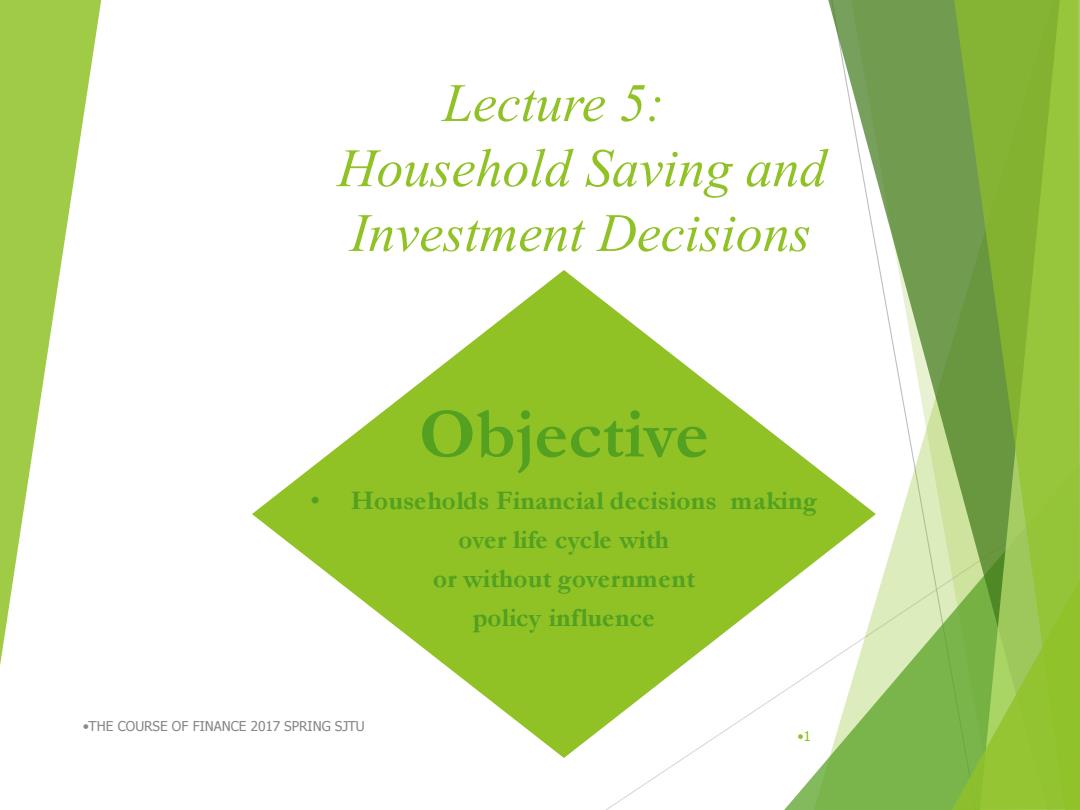
Lecture 5: Household Saving and Investment Decisions Objective Households Financial decisions making over life cycle with or without government policy influence .THE COURSE OF FINANCE 2017 SPRING SJTU 1
Lecture 5: Household Saving and Investment Decisions •THE COURSE OF FINANCE 2017 SPRING SJTU •1 Objective • Households Financial decisions making over life cycle with or without government policy influence
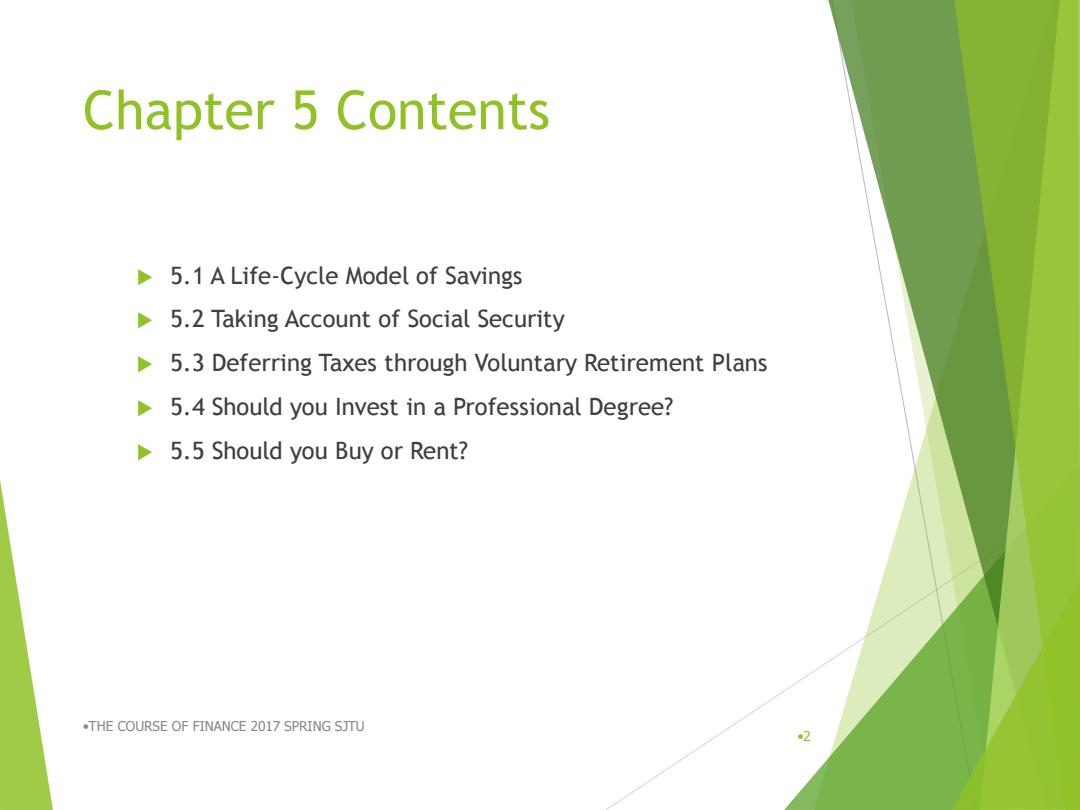
Chapter 5 Contents 5.1 A Life-Cycle Model of Savings 5.2 Taking Account of Social Security 5.3 Deferring Taxes through Voluntary Retirement Plans 5.4 Should you Invest in a Professional Degree? 5.5 Should you Buy or Rent? .THE COURSE OF FINANCE 2017 SPRING SJTU 2
Chapter 5 Contents 5.1 A Life-Cycle Model of Savings 5.2 Taking Account of Social Security 5.3 Deferring Taxes through Voluntary Retirement Plans 5.4 Should you Invest in a Professional Degree? 5.5 Should you Buy or Rent? •THE COURSE OF FINANCE 2017 SPRING SJTU •2
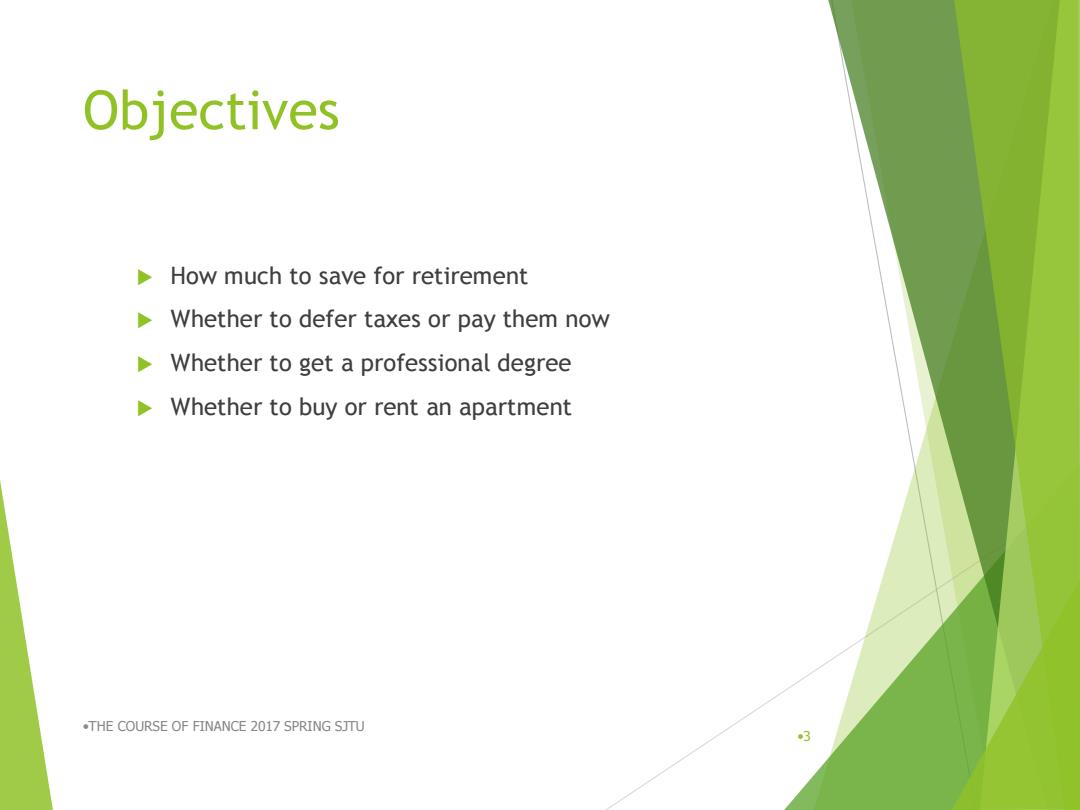
Objectives How much to save for retirement Whether to defer taxes or pay them now Whether to get a professional degree Whether to buy or rent an apartment .THE COURSE OF FINANCE 2017 SPRING SJTU y
Objectives How much to save for retirement Whether to defer taxes or pay them now Whether to get a professional degree Whether to buy or rent an apartment •THE COURSE OF FINANCE 2017 SPRING SJTU •3

5.1 A Life-Cycle Model of Saving Assume that you are currently 35 years old,expect to retire in 30 years at 65,and then live for 15 more years until 80 Your real labor income is $30,000/year until age 65 Interest rates exceed inflation by 3%/year .THE COURSE OF FINANCE 2017 SPRING SJTU
5.1 A Life-Cycle Model of Saving Assume that you are currently 35 years old, expect to retire in 30 years at 65, and then live for 15 more years until 80 Your real labor income is $30,000/year until age 65 Interest rates exceed inflation by 3%/ year •THE COURSE OF FINANCE 2017 SPRING SJTU •4

How Much Should I Save and Consume? Two approaches are suggested: 1.Target replacement rate of pre-retirement income 2.Maintain the same level of consumption spending .THE COURSE OF FINANCE 2017 SPRING SJTU 5
How Much Should I Save and Consume? Two approaches are suggested: 1. Target replacement rate of pre-retirement income 2. Maintain the same level of consumption spending •THE COURSE OF FINANCE 2017 SPRING SJTU •5
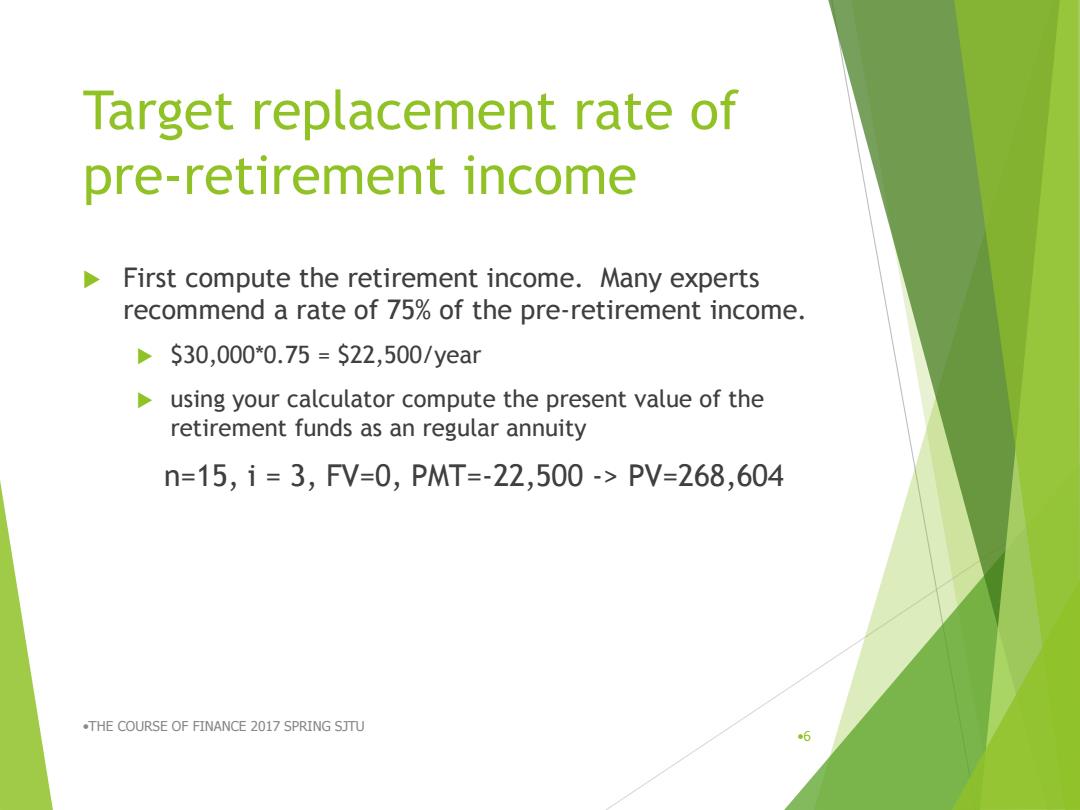
Target replacement rate of pre-retirement income First compute the retirement income.Many experts recommend a rate of 75%of the pre-retirement income. $30,000*0.75=522,500/year using your calculator compute the present value of the retirement funds as an regular annuity n=15,i=3,V=0,PMT=-22,500->PV=268,604 .THE COURSE OF FINANCE 2017 SPRING SJTU 6
Target replacement rate of pre-retirement income First compute the retirement income. Many experts recommend a rate of 75% of the pre-retirement income. $30,000*0.75 = $22,500/year using your calculator compute the present value of the retirement funds as an regular annuity n=15, i = 3, FV=0, PMT=-22,500 -> PV=268,604 •THE COURSE OF FINANCE 2017 SPRING SJTU •6
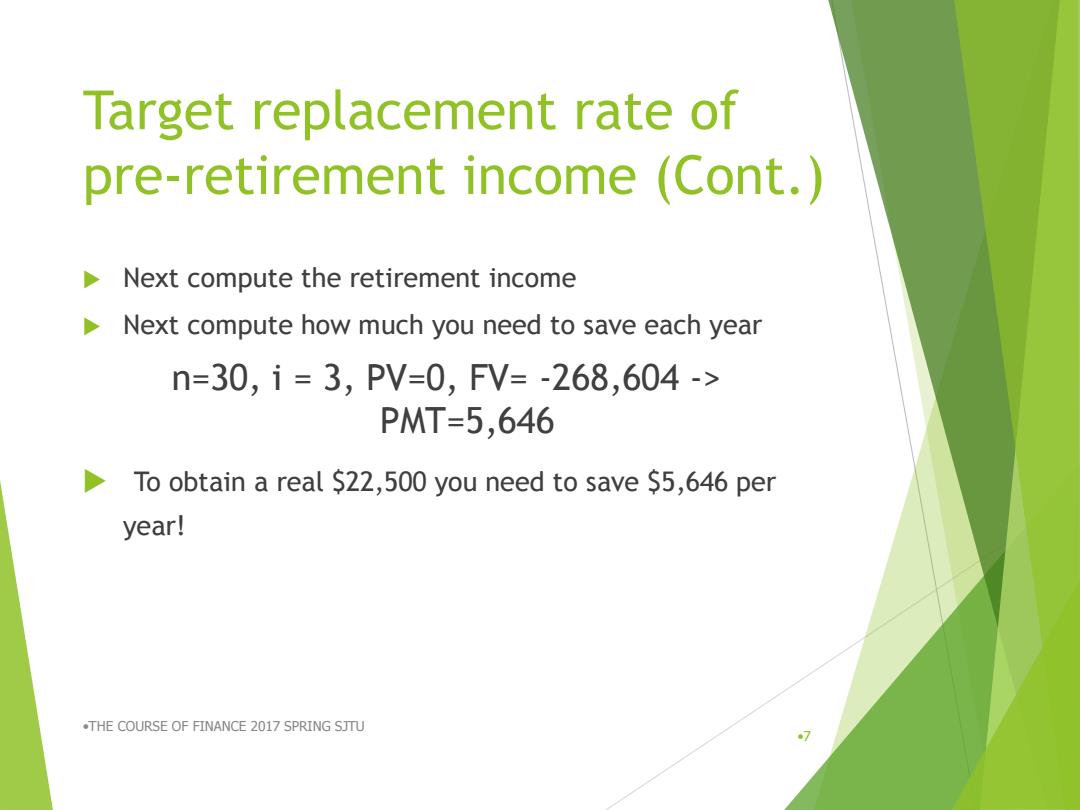
Target replacement rate of pre-retirement income (Cont. Next compute the retirement income Next compute how much you need to save each year n=30,i=3,PV=0,FV=-268,604-> PMT=5,646 To obtain a real $22,500 you need to save $5,646 per year! .THE COURSE OF FINANCE 2017 SPRING SJTU
Target replacement rate of pre-retirement income (Cont.) Next compute the retirement income Next compute how much you need to save each year n=30, i = 3, PV=0, FV= -268,604 -> PMT=5,646 To obtain a real $22,500 you need to save $5,646 per year! •THE COURSE OF FINANCE 2017 SPRING SJTU •7
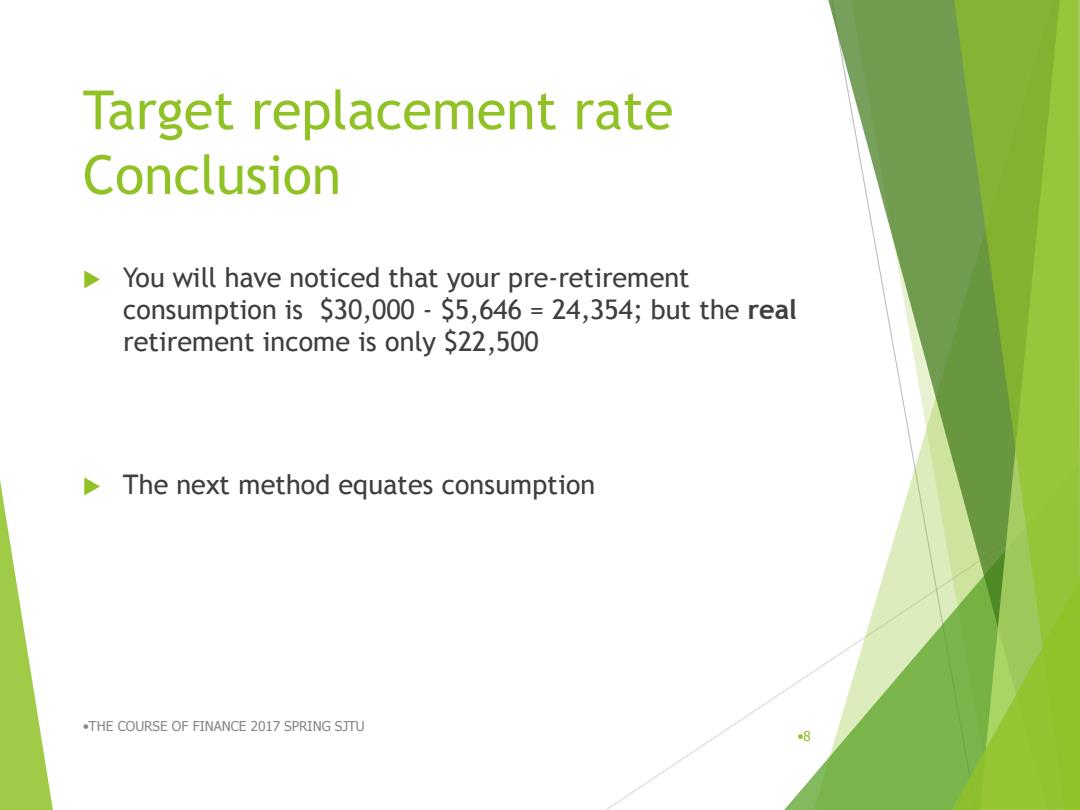
Target replacement rate Conclusion You will have noticed that your pre-retirement consumption is $30,000-$5,646 24,354;but the real retirement income is only $22,500 The next method equates consumption .THE COURSE OF FINANCE 2017 SPRING SJTU 8
Target replacement rate Conclusion You will have noticed that your pre-retirement consumption is $30,000 - $5,646 = 24,354; but the real retirement income is only $22,500 The next method equates consumption •THE COURSE OF FINANCE 2017 SPRING SJTU •8
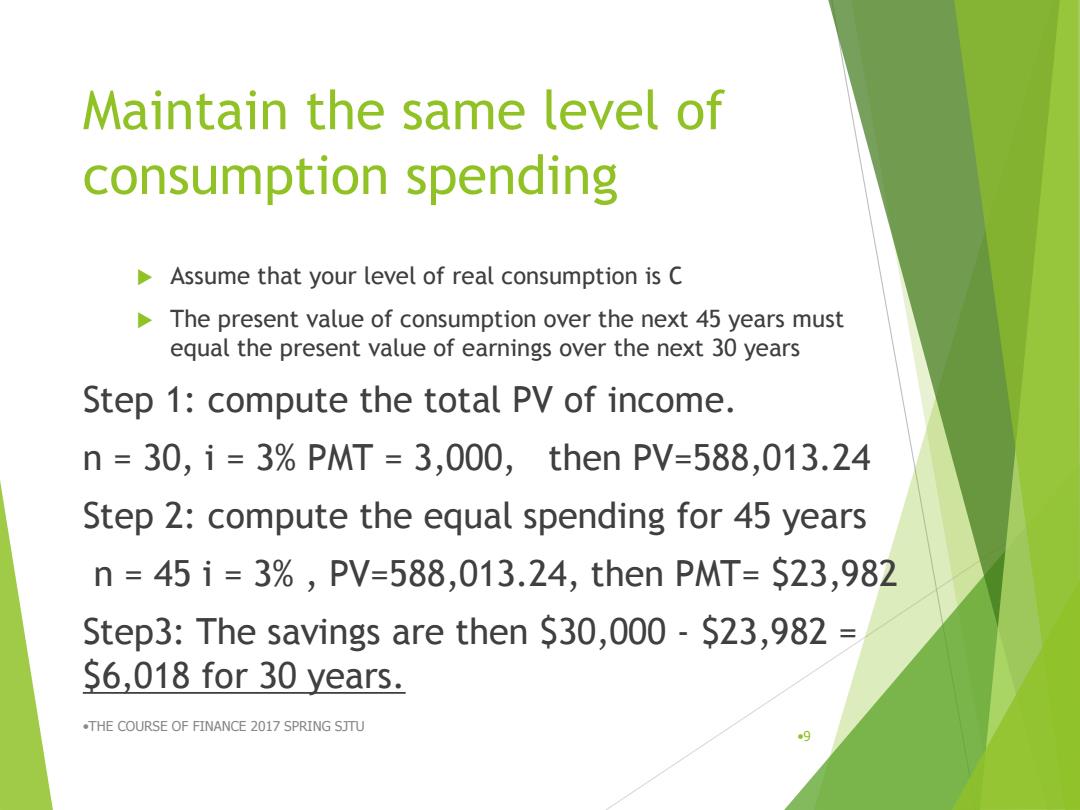
Maintain the same level of consumption spending Assume that your level of real consumption is C The present value of consumption over the next 45 years must equal the present value of earnings over the next 30 years Step 1:compute the total PV of income. n=30,i=3%PMT=3,000,then PV=588,013.24 Step 2:compute the equal spending for 45 years n=45i=3%,PV=588,013.24,then PMT=S23,982 Step3:The savings are then $30,000-$23,982 S6,018 for 30 years. .THE COURSE OF FINANCE 2017 SPRING SJTU 9
Maintain the same level of consumption spending Assume that your level of real consumption is C The present value of consumption over the next 45 years must equal the present value of earnings over the next 30 years Step 1: compute the total PV of income. n = 30, i = 3% PMT = 3,000, then PV=588,013.24 Step 2: compute the equal spending for 45 years n = 45 i = 3% , PV=588,013.24, then PMT= $23,982 Step3: The savings are then $30,000 - $23,982 = $6,018 for 30 years. •THE COURSE OF FINANCE 2017 SPRING SJTU •9

Human Capital and Permanent Income Human capital The present value of one's future labor income Permanent income The constant level of(real)consumption (such as C in the formula)spending that has a present value equal to one's human capital 5 30 C (1+2)= (1+) Human capital .THE COURSE OF FINANCE 2017 SPRING SJTU 10
Human Capital and Permanent Income Human capital The present value of one’s future labor income Permanent income The constant level of (real) consumption (such as C in the formula)spending that has a present value equal to one’s human capital •THE COURSE OF FINANCE 2017 SPRING SJTU •10 Human capital